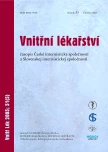-
Medical journals
- Career
Cause of clinical manifestations of chronic venous insufficiency in patients with overweight and obesity
Authors: D. Musil 1; J. Herman 2
Authors‘ workplace: Nestátní interní a cévní ambulance, II. poliklinika, Olomouc 1; II. chirurgická klinika Lékařské fakulty UP a FN Olomouc, přednosta prof. MUDr. Miloslav Duda, DrSc. 2
Published in: Vnitř Lék 2005; 51(5): 523-528
Category: Original Contributions
Overview
The aim of the paper was to answer the question to what degree clinical manifestations of chronic venous insufficiency in patients with overweight and obesity have connection with increased body weight, possibly with its various complications, and to what degree they are based on underlying primary infliction of lower limb venous system. Population consisted of 100 patients ((78 females a 22 males) with manifestations of chronic venous insufficiency (C1–C6 according to CEAP). Nutrition status of the patients was evaluated based on BMI: control group with BMI ≥ 20–25 kg/m2 (n = 49), monitored group with BMI ≥ 26 kg/m2 (n = 43) was divided in overweight patients (BMI ≥ 26–29 kg/m2) and obese patients (BMI ≥ 30 kg/m2). In control group of patients with BMI ≥ 20–25 kg/m2 we demonstrated primary infliction of venous wall (67.3%) as a main cause of clinical manifestations of chronic venous insufficiency, which was exhibited by reflux in superficial venous system and supported by positive family history (77.6%) and high correlation between positive family history and the infliction of superficial veins (67.3%). In monitored group with BMI ≥ 26 kg/m2 and BMI ≥ 30 kg/m2) causes of clinical manifestations of chronic venous insufficiency can be divided at least into three groups: 1. primary infliction of venous wall (55% verweight patients, 20.8% obese patients) supported by positive family history, 2. obesity as a primary cause of symptoms of chronic venous insufficiency, 3. obesity as a main risk factor of various diseases which can lead to secondary posttraumatic or postthrombotic infliction of lower limb venous system.
Key words:
chronic venous insufficiency – duplex sonography – risk factors – overweight – obesity – BMI – heredity – reflux
Sources
1. Agus GB et al. Guidelines on compression therapy. Acta Phlebologica 2001; 2(Suppl 1): 1–24.
2. Brand FN et al. The epidemiology of varicose veins: The Framingham Study. Am J Prev Med 1998; 4 : 96–101.
3. Fowkes FG, Evans CJ, Lee AJ. Prevalence and risk factors of chronic venous insufficiency. Angiology 2001; 52(Suppl 1): S5–S15.
4. Jawien A. The influence of enviromental factors in chronic venous insufficiency. Angiology 2003; 54(Suppl 1): S19–S31.
5. Lacroix P, Abovans V, Preux P et al. Epidemiology of venous insufficiency in an occupational population. Int Angiol 2003; 22(2): 172–176.
6. Musil D, Herman J. Anatomické a hemodynamické změny na žilním řečišti dolních končetinách postižených chronickou žilní insuficiencí. Vnitř Lék 2003; 49(8): 610–617.
7. Padberg F, Cerveira JJ, Lal BK et al. Does severe venous insufficiency have a different etiology in the morbidly obese? Is it venous? J Vasc Surg 2003; 37(1): 79–85.
8. Sadick NS. Predisposing factors of varicose veins and teleangiectatic leg veins. J Dermatol Surg Oncol 1992; 18 : 883–886.
Labels
Diabetology Endocrinology Internal medicine
Article was published inInternal Medicine

2005 Issue 5-
All articles in this issue
- Prevention of venous thrombosis and pulmonary embolism in the department of internal medicine
- Cause of clinical manifestations of chronic venous insufficiency in patients with overweight and obesity
- Urgent endoscopic papilosphincterotomy in individuals older than 70 years
- Portal vein flow is associated to central hemodynamics and biochemical signs of liver lesion in chronic congestive heart failure
- Catheter ablation of atrioventricular nodal reentry tachycardia – non invasive possibility of diagnostics, immediate and 1 year results following radiofrequency ablation and 1 year follow up of 40 patients treated in 2002
- Vasospastic angina pectoris – pathogenesis, diagnostics and treatment
- Prolonged administration of low-molecular heparins in the prophylaxis of postoperative thrombosis
- Genetic tests in prediction of effectiveness and toxicity of chemotherapy in cancer patients
- Pneumology problems of patients with diabetes mellitus
- Obstructive sleep apnea, hypertension and erectile dysfunction
- Detection of the site of recurrent bleeding in small bowel in patient with m. Rendu-Osler-Weber by means of scintigraphy with 99mTc-pertechnetate in vivo labeled red blood cells
- Systemic AL-amyloidosis with dominant clinical manifestation in digestive system
- Our experience in the treatment of membranous nephropathy with cyclosporine
- Acute myocarditis, prevalence, diagnosis and treatment in local hospital
- Internal Medicine
- Journal archive
- Current issue
- Online only
- About the journal
Most read in this issue- Acute myocarditis, prevalence, diagnosis and treatment in local hospital
- Vasospastic angina pectoris – pathogenesis, diagnostics and treatment
- Our experience in the treatment of membranous nephropathy with cyclosporine
- Pneumology problems of patients with diabetes mellitus
Login#ADS_BOTTOM_SCRIPTS#Forgotten passwordEnter the email address that you registered with. We will send you instructions on how to set a new password.
- Career

